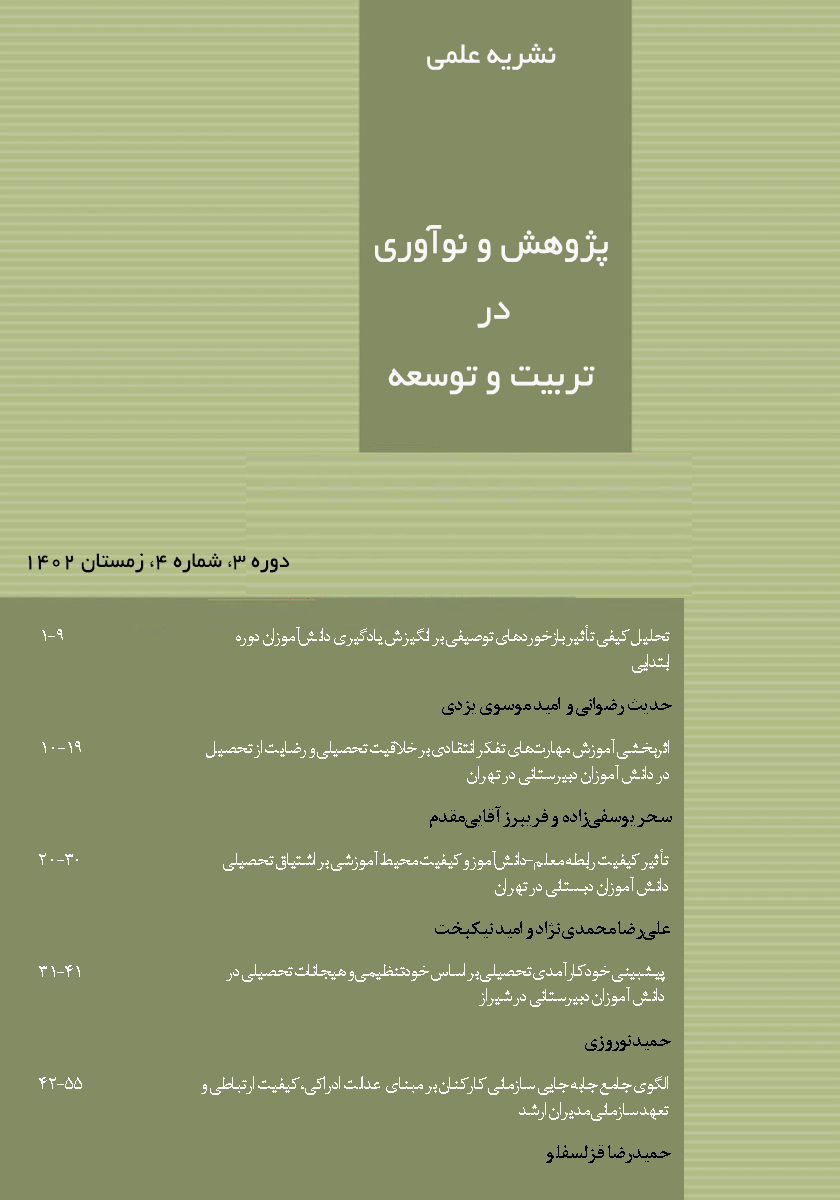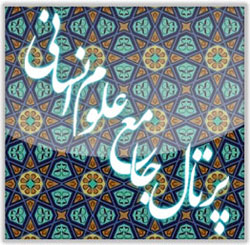تحلیل کیفی روشهای تدریس تعاملی مبتنی بر فناوری بر افزایش درک مفهومی دانشآموزان
کلمات کلیدی:
تدریس تعاملی, فناوری آموزشی, درک مفهومی, آموزش دیجیتال, یادگیری تعاملی, مهارتهای شناختی, چالشهای آموزشیچکیده
این پژوهش با هدف بررسی تأثیر روشهای تدریس تعاملی مبتنی بر فناوری بر افزایش درک مفهومی دانشآموزان و تحلیل چالشها و فرصتهای ناشی از این رویکرد آموزشی انجام شد. این مطالعه به روش کیفی انجام شده و دادهها از طریق مصاحبههای نیمهساختاریافته با ۲۴ معلم و متخصص آموزشی در شهر تهران جمعآوری شده است. نمونهگیری بهصورت هدفمند انجام شده و فرایند گردآوری دادهها تا رسیدن به اشباع نظری ادامه یافته است. دادههای گردآوریشده با استفاده از روش تحلیل محتوای کیفی و نرمافزار NVivo تحلیل شدهاند. در این فرایند، کدگذاری باز، محوری، و انتخابی بهکار گرفته شده است تا الگوهای اصلی مرتبط با موضوع پژوهش استخراج شود. نتایج پژوهش نشان داد که فناوریهای تعاملی در آموزش، دسترسی آسانتر به منابع یادگیری، افزایش انگیزه دانشآموزان، تقویت تعاملات آموزشی، و بهبود درک مفهومی را تسهیل میکنند. همچنین، فناوری موجب افزایش مهارتهای شناختی و اجتماعی در دانشآموزان شده است. با این حال، چالشهایی همچون محدودیتهای زیرساختی، کمبود دانش و مهارت معلمان، و مشکلات انضباطی در کلاسهای مجازی بهعنوان موانع اصلی شناسایی شدند. استفاده از روشهای تدریس تعاملی مبتنی بر فناوری، درک مفهومی دانشآموزان را ارتقا داده و یادگیری را به فرایندی پویا و جذاب تبدیل کرده است. بااینحال، برای اجرای موفق این روشها، لازم است که زیرساختهای آموزشی تقویت شوند، معلمان آموزشهای لازم را دریافت کنند، و راهکارهایی برای مدیریت چالشهای اجرایی تدوین شود.
دانلودها
مراجع
Altınöz, M., Çakıroğlu, D., & Çöp, S. (2013). Effects of talent management on organizational trust: a field study. ProcediaSocial and Behavioral Sciences, 99, 843-851. https://doi.org/10.1016/j.sbspro.2013.10.556
Baker, J., Wattie, N., & Schorer, J. (2019). A proposed conceptualization of talent in sport: The first step in a long and winding
road. Psychology of Sport and Exercise, 43, 27-33. https://doi.org/10.1016/j.psychsport.2018.12.016
Bolander, P., Werr, A., & Asplund, K. (2017). The practice of talent management: a framework and typology. Personnel
Review, 46(8), 1523-1551. https://doi.org/10.1108/PR-02-2016-0037
Buekers, M., Borry, P., & Rowe, P. (2015). Talent in sports. Some reflections about the search for future champions. Movement
& Sport Sciences-Science & Motricité, 88, 3-12. https://doi.org/10.1051/sm/2014002
Dries, N. (2013). The psychology of talent management: A review and research agenda. Human Resource Management Review,
(4), 272-285. https://doi.org/10.1016/j.hrmr.2013.05.001
Henriksen, K., Stambulova, N., & Roessler, K. K. (2010). Successful talent development in track and field: considering the
role of environment. Scandinavian Journal of Medicine & Science in Sports, 20, 122-132. https://doi.org/10.1111/j.1600-
2010.01187.x
Howe, M. J., Davidson, J. W., & Sloboda, J. A. (1998). Innate talents: Reality or myth? Behavioral and brain sciences, 21(3),
-407. https://doi.org/10.1017/S0140525X9800123X
Ingram, T., & Glod, W. (2016). Talent management in healthcare organizations-qualitative research results. Procedia
Economics and Finance, 39, 339-346. https://doi.org/10.1016/S2212-5671(16)30333-1
Issurin, V. B. (2017). Evidence-based prerequisites and precursors of athletic talent: a review. Sports medicine, 47(10), 1993-
https://doi.org/10.1007/s40279-017-0740-0
Larkin, P., & Reeves, M. J. (2018). Junior-elite football: time to re-position talent identification? Soccer & Society, 19(8), 1183-
https://doi.org/10.1080/14660970.2018.1432389
Lewis, R. E., & Heckman, R. J. (2006). Talent management: A critical review. Human Resource Management Review, 16, 139-
https://doi.org/10.1016/j.hrmr.2006.03.001
Mortezaeian, M., Mirzazadeh, Z. S., Keshtidar, M., & Talebpour, M. (2023). Present a model of sports talent management of
Iranian students based on grounded theory. Journal of Strategic Sociological Studies in Sport, 2(4), 389-400.
Mozaffari, H., Shayegan, F., & Mohebi, A. (2023). Designing an Intelligence and Talent Management Pattern for Elementary
School Students. Iranian Journal of Educational Society, 9(1), 349-358.
Naseri Palangard, V., Bahrami, S., Zardashtian, S., & Yousefi, B. (2020). Designing a Family-School Support Model for
Developing Sports Talents: A Grounded Theory Study. Health Promotion Management Quarterly, 10(1), 74-90.
Nazari, R., & Tabesh, S. (2019). Challenges of Sports Development in Iran with an Approach to Talent Identification and
Greenhouse Elite Development. Sport Management and Development, 8(1), 1-14.
Nazarian, M. R., Mahdad, A., Abedi, A., & Nadi, M. A. (2022). Identifying Methods and Components of Teaching and
Developing Its Interpretive Model Based on Teachers' Lived Experiences in Discovering Elementary Students' Science
Talents. Research in Curriculum Planning, 19(72), 35-48.
Norouzi Seyed Hosseini, R. (2020). Understanding the Lived Experience of Sports Public Relations Managers Regarding
Media Crises (A Phenomenological Approach). Scientific Quarterly of Communication Management in Sports Media,
(2), 13-26.
Vaeyens, R., Lenoir, M., Williams, A. M., & Philippaerts, R. M. (2008). Talent identification and development programmes in
sport : current models and future directions. Sports medicine (Auckland, N.Z.), 38(9), 703-714.
دانلود
چاپ شده
ارسال
بازنگری
پذیرش
شماره
نوع مقاله
مجوز
حق نشر 2024 نشریه پژوهش و نوآوری در تربیت و توسعه

این پروژه تحت مجوز بین المللی Creative Commons Attribution-NonCommercial 4.0 می باشد.











